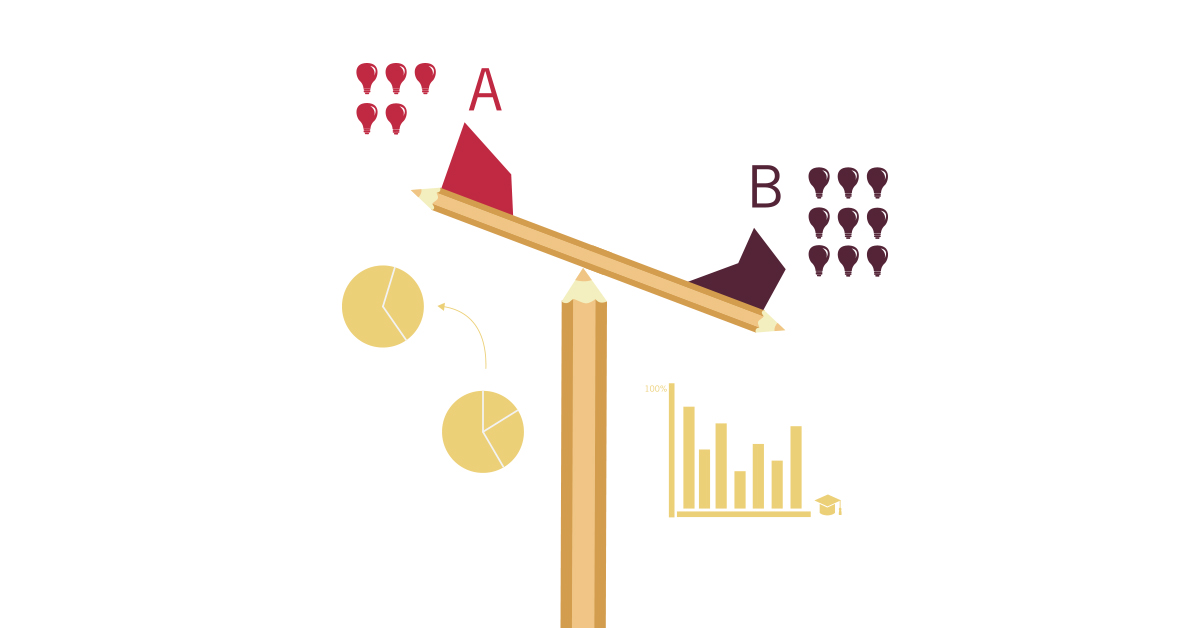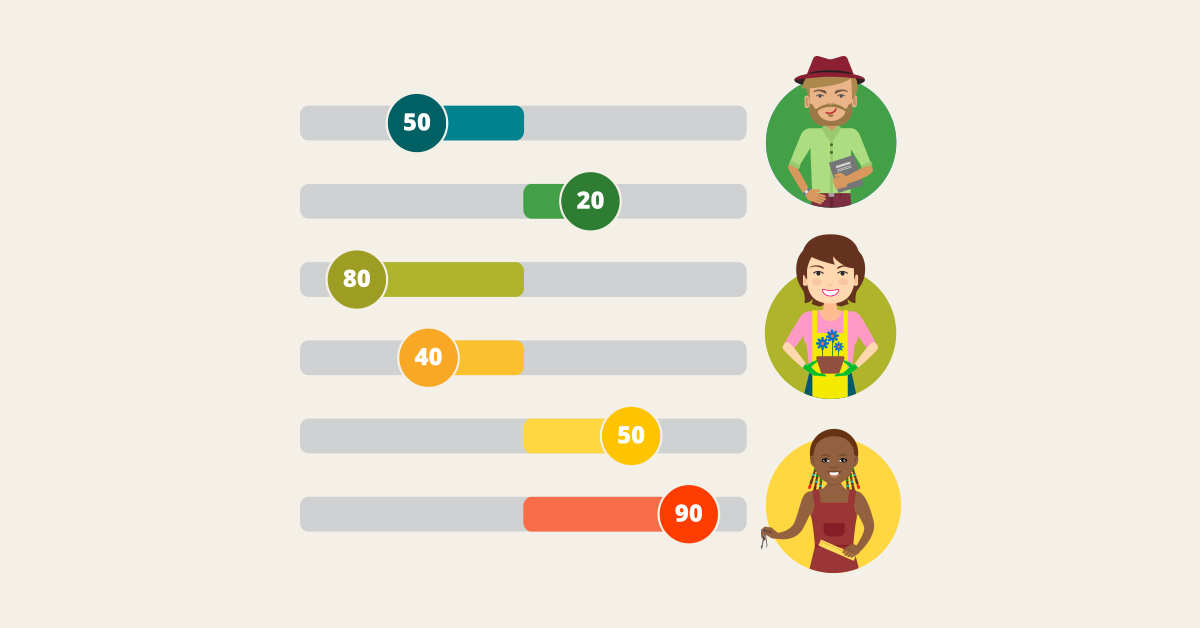With so many different research methods and measurement scales out there, researchers, statisticians, and marketers are often left clueless so as which one they should choose for their particular needs.
To make things even better (or worse?), I introduce you to one of the first scales ever used to measure people’s attitudes on different issues – the Thurstone scale. Even though it’s not as popular these days as it used to be, it still finds its application in different types of surveys.
Before we delve into the survey-specific details, let’s briefly define the Thurstone scale first.
What is the Thurstone Scale?
Developed by Louis Leon Thurstone in 1928, the Thurstone scale was the first formal technique used to measure attitudes. At first, it was used to measure attitudes towards religion, but later it found its application in sociology and psychology.
As one of the leading scaling theorists of the times, Thurstone actually came up with 3 different scales, but when we say Thurstone scale, in most cases we mean the method of equal-appearing intervals, which is why the scale is often referred to as the equal-appearing interval scale.
The other two scales are based on the method of paired comparisons and the method of successive intervals but aren’t used as commonly due to the fact that they are a bit more complex to develop. Still, they rely on the same agree/disagree question type as the equal-appearing interval scale.
Basically, the Thurstone scale consists of a set of statements about a certain issue, each of which has a numerical value stating how (un)favorable it is judged to be. The respondents then tick only those statements to which they agree. After they complete the survey, the mean score is calculated, indicating their attitude on the issue in question.


That’s how a Thurstone scale works in a nutshell, but I’ll later go into more details about how exactly it works and how you can create and use one yourself. Before that, let’s just briefly examine some fields of application of Thurstone scales.
When Should You Use Thurstone Scale Surveys?
This type of surveys can be used to measure, compare, and analyze people’s attitudes on certain issues. The Thurstone scale can be implemented in a wide range of surveys but it’s particularly effective for surveys that:
- Measure opinions, as it produces quantifiable degrees of strength of your respondents’ attitude towards an issue
- Gauge sentiments such as customer or employee satisfaction.
Whatever you intend to use them for, here’s how to create one.
How to Conduct a Thurstone Scale Survey
1. Identify a research topic related to an attitude
Depending on the main goal behind your survey, you need to identify the main research topic that you would like to examine with your survey. If possible, you should narrow the focus to a single issue, so as to get more valid results.
2. Develop a series of agree-disagree statements
The first step of conducting a Thurstone scale survey is to come up with a large number of statements on a particular topic. Basically, your survey should consist of a series of related dichotomous statements to which the respondents would agree or disagree.
3. Assign a score to each of the statements
Each statement should be given a score on the scale of 1 to 11 based on strong you think it is. Usually, the highest score means a strongly favorable position, while the lowest one means the least favorable or neutral stance.
While you could assign the score to each of the statements yourself, that way you risk introducing bias to your survey. In order to obtain reliable results, you need to do whatever you can to avoid bias in research, when making a Thurstone scale survey, you should consider getting a study group or a panel of judges to score the questions.


Have each member of the study group score how strong they think each of the statements is. After that, you should find the median score (more on that below) given to each statement and then order them in ascending order.
How to find the median score (or IQR) for each of the statements
Without a strong background in statistics, you are likely to find this step confusing and difficult. But don’t worry, I’m going to try to simplify it as much as possible. Let’s first briefly define the two values that we’re looking for here.
What’s the median score? In statistics, a median is a value that shows you where the middle of some data set is. It’s found its application in many areas of real life – for example, in Bankruptcy law, which says that you can claim bankruptcy only if you’re below the median income for your state.
So how do you calculate the median? Let’s say our Thurstone scale survey contains 7 questions and your study group has assigned the following scores on the 1-11 scale: 1, 7, 3, 9, 6, 3, 10.
The 1st step is to sort them in ascending order: 1, 3, 3, 6, 7, 9, 10.
The 2nd step is to find the number in the middle. In this case, it’s 6. In other words, 6 is your median score. Okay, it’s easy when you have an odd set of numbers, but what if it’s an even number of questions?
Let’s say we’ve added one question (with the score of 11) to our Thurstone scale survey and there’s 8 of them now. Here they are in the ascending order: 1, 3, 3, 6, 7, 9, 10, 11. As with even number of values it’s impossible to find the middle one, we take the two numbers in the middle (6 and 7, in this case) and divide them by 2 to get the average. So, our median score in this case is (6+7) / 2 = 6.5.
In case you’re dealing with a larger set with hundreds of numbers (which is unlikely going to be the case with surveys), it may be more difficult to determine what the middle numbers are. In that case, you can use the following median formula:
{(n + 1) ÷ 2}th, where “n” represents the number of items in a particular set, while“th” stands for the (n)th number.
In our example with 7 questions, n=7 so {(7 + 1) ÷ 2}th = 4th, meaning the 4th number in the set is our median.
Basically, that’s how you can calculate it manually, but those of you who don’t find maths and statistics fun can simply use a median calculator or use the median function in Excell to do the math for you.


Another option is to use the IQR to score your questions. IQR or interquartile range identifies where the middle 50% is in a particular data set. It can also be calculated manually or you can simply use this calculator where you just have to input all the numbers in the set and it will calculate the interquartile range.
Even though you can use both median value or IQR to calculate the “value” of each of the statements in your Thurstone scale, I believe that it’s much simpler (and reliable enough) to base the scoring on median values.
How to Analyze the Thurstone Scale Survey Results
Once you’ve created your Thurstone scale survey, scored the statements (those scores are not to be shown to respondents as they may influence the responses and cause the acquiescence bias), and distributed the surveys to respondents, it’s time to analyze the results and measure their attitude towards the issues in question.


Once again, when taking the Thurstone scale surveys, respondents are expected to either agree or disagree with the statements included in the survey. After you’ve received their responses, simply sum the median scores of each of the statements they agreed with and divide the result by the number of statements they checked.
If, for example, a respondent agreed with the statements which have median scores of 3.5, 7, 9.5, 4, and 10, their attitude score is (3.5 + 7 + 9.5 + 2 + 9) / 5 = 6.2. As this score is just above the midpoint of our 1-11 scale, we can conclude that the respondent has a slightly favorable attitude towards the topic in question.
Thurstone scale vs. Likert scale
The Likert scale was developed in 1932 out of the Thurstone scale (which was invented 4 years before, as already mentioned). The Likert scale was devised out of the need to simplify the original Thurstone scale and make it more reliable.
With its complex scoring system, developing Thurston scales can be time-consuming and more complex compared to the Likert scale. Plus, the involvement of intermediary judges can add the factor of potential unreliability or bias to Thurstone scales.
If you would like to learn more about Likert scales, check out this detailed guide on how to create a Likert scale survey.
Limitations of Thurstone Scale Questions
They are time-consuming. Thurstone scale questions are always created and administered in two steps – first, you have to write a series of statements and then your study group (or a panel of judges) need to rate them and there needs to be consensus on which of the initial questions should be included in the final survey.
They are complex. Most of the people using surveys just want to be able to create a list of questions, distribute them to respondents, and be able to analyze the results and draw conclusions. No one wants to spend time calculating the median or dealing with other “complex” math.
Scarcity of answer options. Only two, actually – agree or disagree.
Luckily, there’s a plethora of different question and answer options with online surveys, which are easy to create (it usually takes less than 10 minutes) and distribute, and offer rich reporting and analytics features.
To easily create your own survey in just a few steps, click on the image below!
